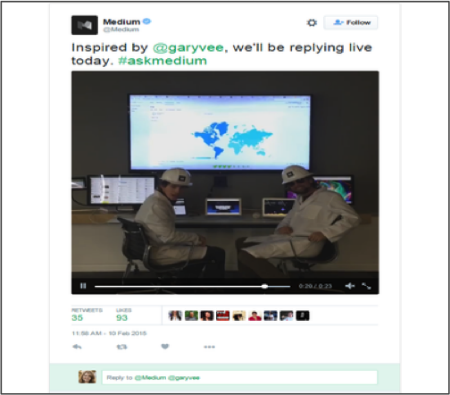
As the digital world we live in becomes increasingly cluttered, marketers are constantly refining their content marketing strategies and embracing new tactics to stay competitive. And Real-time video is one of those tactics that is allowing marketers to reach new audiences and increase customer engagement.
Video has been viewed as an effective marketing tactic for a number of years. However, the time and resources needed to create quality video had many marketers focusing on other things. Fortunately, the introduction of real-time video platforms and applications such as Ustream and Meerkat now presents marketers with some fairly easy and cost-effective video content marketing options.
And the launch of real-time video applications could not have come at a better time. Why?
Because online video is one of the fastest growing mediums in history. According to HighQ, a leading-edge corporate software company, 78 percent of people watch videos online each week and 55 percent of people watch videos online every day.
Definition of Real-Time Video
Much like your evening news broadcast, real-time video is a live video feed that disseminates content to an audience as it happens.
When it comes to real-time video as a content marketing tactic, some of the most traditional examples are live webinars and podcasts. New technology and applications such as Periscope, Facebook Live, Blab and Google Hangouts are taking real-time video to a new level by offering user-friendly platforms for streaming the video. In addition, many of these platforms allow users to interact with the publishers through comment streams.
Some of the ways real-time video can be used include: hosting a how-to demonstration for a product, interviewing current users on the benefits of a particular product or service, broadcasting live from events, or having a customer service representative answer commonly asked questions.
Pros
As video continues to be an important part of daily life for consumers, real-time video offers brands the ability to visually captivate its audience while providing useful information. Here are some of the other major benefits of real-time video:
- Since real-time video is interactive, it allows brands to engage with customers almost instantly and creates more opportunity for discussion.
- The accessibility of real-time video apps means brands can produce quality content without spending a lot of money.
- On many platforms, the live video stream can be archived and turned into a permanent piece of video content that will continue to drive website traffic.
- Like any other piece of content, real-time video provides brands with the opportunity to expand and repurpose that content.
- Real-time video also means real-time insights. While video content is airing, you’ll be able to see how it is performing.
Cons
While real-time video can be a useful content marketing tactic, it does have its drawbacks. Here are some of the disadvantages of real-time video:
- There’s a risk of inappropriate comments slipping through since it’s hard to monitor all the users interacting with your content at once.
- Since the majority of these videos will be watched on mobile devices poor connection speeds or other technical difficulties could deter users from sticking around to see your content.
- From music to branded images, live video streams can unintentionally infringe on copyrights.
What Experts Are Saying
“Video technologies are improving dramatically and rapidly, supporting mobile and ubiquitous real-time video experiences. Low-cost, simple platforms for real-time video will become an essential part of the way we communicate with each other, and will spawn the next generation of consumer behavior, business practice, media culture and economics, and innovation policy.”
Institute for the Future (Source: iftf.org)
“Blab, which is free, is spectacularly simple to use, has features you won’t find on other platforms (yet) and is a very quick way to reach and engage with a vast new audience worldwide. The key to Blab’s instant popularity is that it is essentially plug and play. It works on both desktop and mobile devices, and the two integrate seamlessly. And it is being constantly updated, in real time, by Team Blab, 12 people who work out an office in San Francisco.”
B.L. Ochman, CEO of Maximum-Plus (Source: whatsnextblog.com)
“Periscope took only ten days to hit 1 million users; and four months after its launch date, the app was enjoying 10 million users. Even more staggering than the size of this user base is the amount of content users are consuming: 40 years of content is viewed every day on Periscope. Yes . . . 40 years.”
Kim Garst, Founder and CEO of Boom! Social (Source: Entrepreneur.com)
Brand Examples of Real-Time Video
Ball Canning

Ball Canning, the maker of the popular Ball canning jars, held a live video session demonstrating pickling best practices and a real-time Q&A. People were able to submit questions and receive answers in real time.
Medium

Medium, a publishing platform for writers, was looking for a way to make itself more human and accessible—and video seemed like the perfect way to do just that. Users were able to tweet questions to the Medium’s User Happiness team with the hashtag #askmedium, and they received real-time video responses.
(Medium’s video initiative was profiled by Wistia.)
General Electric

General Electric (GE) was quick to experiment with real-time video. According to Practical ECommerce, in late March 2015 GE Creator in Residence and YouTube personality Sally Le Page held a behind-the-scenes interview with astrophysicist Neil deGrasse Tyson and scientist Bill Nye. Then in July 2015, GE launched #DRONEWEEK on Periscope, broadcasting live video film by a GE-engineered drone flying from coast to coast. After the flight, GE took the videos and edited them into highlight videos.
Real-Time Video Best Practices
- Do your research. If you decide that real-time video is a content marketing tactic that could benefit your overall marketing strategy, make sure you research the different platforms and applications. All have their own unique pros and cons.
- Create a plan. Like any marketing tactic, planning makes perfect. Outline the topics or products you’d like to showcase in your video, create a timeline for how the videos will be promoted and executed, and also make a plan for how you can repurpose the content later.
- Use existing content to get started. Repurposing content is a common marketing practice, and when it comes to launching a real-time video strategy, this is a great place to start. As mentioned above, some ideas include demonstrating how a product works or having a customer service rep answer commonly asked questions.
- Share something useful, interesting or compelling. This one is a no-brainer, but it still must be said. Video is like any other piece of content. It should provide the answers and information your target audience is looking for. Don’t make a video just to make a video. Be purposeful.
- Know your audience. Not every audience is primed for video. Make sure you understand your audience and determine whether or not they would benefit from real-time video content.
- Research your guests. If you’re planning on using Blab to conduct interviews or panel discussions, make sure your guest speakers are relevant and comfortable with the live aspect of the platform.
- Guide users to the next step. What do you want users to do when they’re done watching your video stream? Make it easy for users to find other content and continue to engage with your brand.
Software & Resources
There are a number of real-time video platforms and applications–and more are surely to come. From mobile apps to serious software, some of the most well-known are:
Of course, the TopRank Marketing Blog has a number of helpful posts, too:
- 7 Steps for Using Periscope to Better Engage Your Target Audience
- 5 Opportunities to use BLAB for Digital Marketing
- How Retailers Are Boosting Sales With B2C Video Content
Real-time video presents brands with the opportunity to engage with customers as if they were sitting across from one another. However, real-time video isn’t necessarily a viable content marketing option for everyone. Before you integrate real-time video into your content marketing strategy, analyze your audience and determine how and if real-time video can deliver the information they need, when they need it.
What is your experience with real-time video? Do you have any favorite platforms? Tell us in the comments section below.
Did you like this post? If so, check out our content marketing tactics index page with links to over 25 helpful posts just like this one!
Header image via Shutterstock


